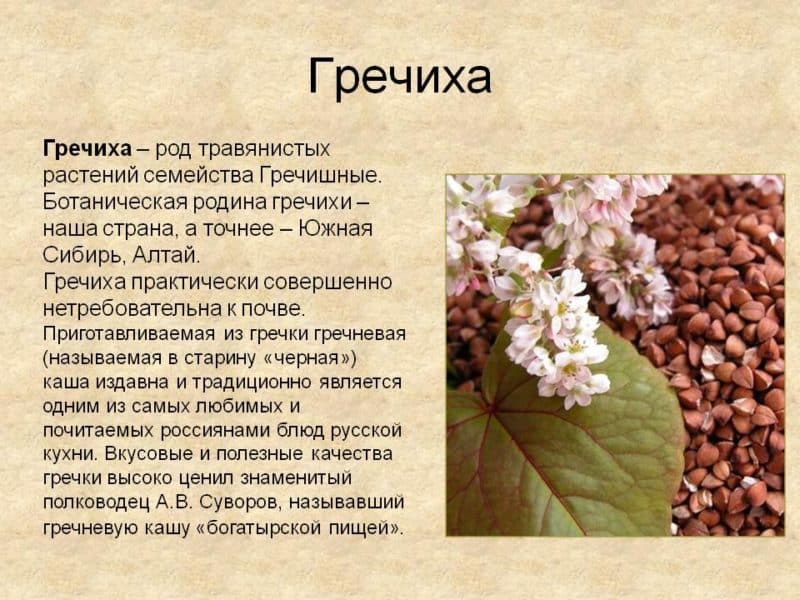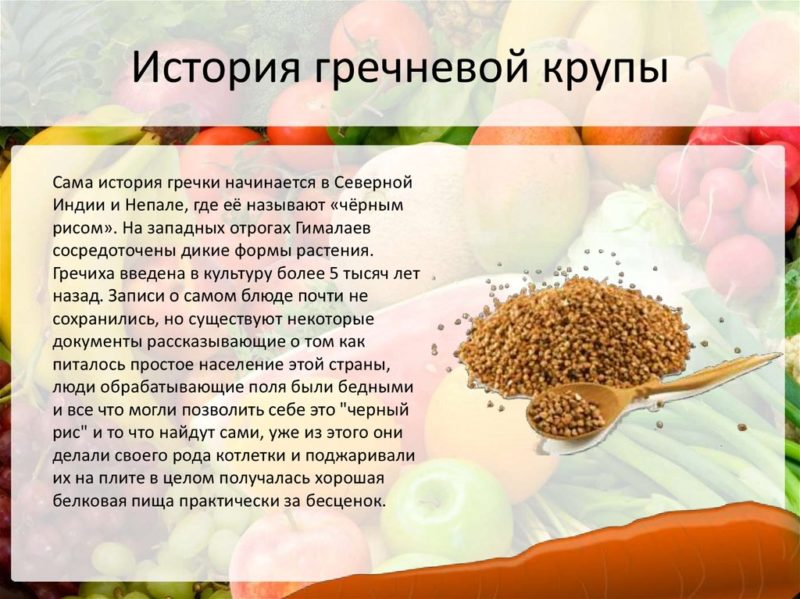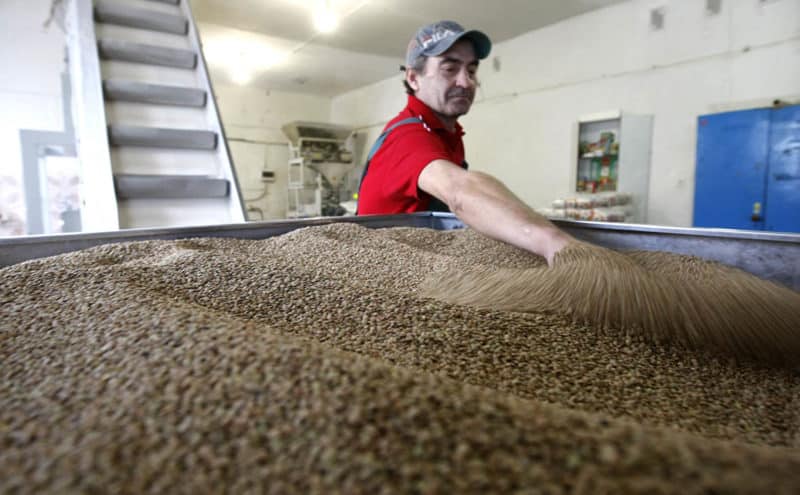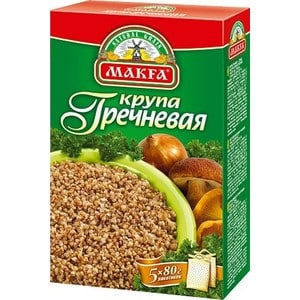All about buckwheat: what it is and where it comes from, history of origin and quality assessment
Buckwheat is a popular cereal that is considered one of the healthiest. Nutritionists recommend including it in the diet for various health problems, including obesity. The origin and history of the appearance of buckwheat in Rus' is interesting: now few people know that several hundred years ago the Slavs had no idea about it.
All about buckwheat

Buckwheat is a cereal obtained by growing common buckwheat (edible or seed). This is a grain crop, the seeds of which are used as food not only for humans, but also for animals.
Buckwheat grains are used to prepare a large number of dishes: porridges, soups, baked goods.
Reference. Buckwheat - a honey plant, from which beekeepers obtain honey during abundant flowering.
The degree of processing significantly affects the color of buckwheat. It can be either green, not heat-treated, or light brown and black, depending on the degree of roasting.
The history of buckwheat
Already in the 10th century. Buckwheat porridge became one of the most beloved among the Slavs. Because of its unattractive appearance, aristocrats disparagingly called it “black porridge” and for a very long time considered it food only for commoners.
Where did it come from?
Initially (more than 5 thousand years ago), the culture grew only in the highlands of the Himalayas. Buckwheat is native to Northern India and Nepal. In these places there are still wild thickets of this plant.
Buckwheat gradually spread throughout the world, appearing in the 15th century. BC e. in China, Japan and Korea, and later in Central Asia, the Middle East and the Caucasus. Much later they learned about it in European countries. Presumably the culture was brought there during the Tatar-Mongol invasion.
Nowadays, it is most consumed by residents of Russia and the CIS countries. Abroad, buckwheat is more often used as a food additive in baking.
Where did the name come from
At home, buckwheat is called “black rice”, in some European countries (Portugal, Spain, Belgium and France) - “Arab grain”, in Italy and Germany - “Turkish” or “pagan grain”.
In Greece, this grain is called “black wheat”. In other European countries it is called “beech wheat” due to the grain’s similarity in shape to beech nuts.
Under the names “buckwheat” or “buckwheat” it is known only in Russia and the CIS countries. This name came, according to one version, from the name of the exporting country, since the first deliveries to Rus' in the 7th century. were from Greece. According to historian V.V. Pokhlebkin, this plant was grown for many years only by Greek monks at monasteries.
When did it appear
The first official information about buckwheat was discovered in the ancient chronicle “The Tale of Igor’s Campaign,” which was written at the end of the 12th century. However, archaeological excavations, during which dishes with cereals were found, indicate that they appeared in the 3rd–1st centuries. BC e.
As agriculture developed in Ancient Rus', the popularity of buckwheat increased. So, already in the 15th century. it began to be cultivated over large areas, and by the 17th century. The cereal was considered the national dish of the country.
At the same time, buckwheat began to be used not only for cereals, but also in folk medicine and beekeeping. Honey from this plant is considered one of the most useful.
Industrial processing of buckwheat

Currently, not only porridge, but also other dishes are prepared from buckwheat grains. For baking, buckwheat flour is used, which is mixed with wheat flour to increase viscosity. Cereals are included in children's and diet menus.
- kernel — whole grain, during processing of which only the outer shell is removed;
- done (chaff) - chopped grains with the husks removed;
- Smolensk buckwheat - finely crushed kernels.
Grain processing takes place in several stages:
- Machine cleaning. Used to remove mineral impurities.
- Steaming. To ensure that the husk is easily separated, the grain is steamed for 1 hour at +130°C and a pressure of 0.3 MPa.
- Peeling and separation. The raw materials are cleared of husks and divided into 8 fractions.
- Roasting. The hot air dries out the grain, which turns brown as a result.
- Removal of low-quality and poorly cleaned kernels.
- Packing. After all the activities, the cereal is packed into bags depending on the variety and sent for implementation.
To prepare buckwheat flour, grains that have gone through all stages of processing are used. In terms of quality and taste, it is very different from wheat: the color of buckwheat flour is grayish-brown, the taste is slightly bitter. It is used to make baked goods with low gluten content.
Organoleptic quality assessment
Organoleptic (commodity) assessment of the quality of buckwheat is carried out according to 3 criteria: color, taste and smell.This study was carried out in the laboratory of the Department of Commodity Research and Expertise of Food Products of the Russian University of Cooperation in Vladikavkaz.
For the evaluation, we used buckwheat from the most popular producers in Russia: Makfa, National and Uvelka.
| Manufacturer | Color | Smell | Taste |
| "Makfa" | All shades of dark brown. | Natural, characteristic of cereals. There are no foreign odors (mold, mustiness). | Traditional, without bitterness or acidity. |
| "National" | All shades of dark brown. | Natural. There are no unusual impurities. | Characteristic of buckwheat, without any foreign taste. |
| "Uvelka" | All shades of brown. | There are no foreign odors (mold, mustiness). | There are no foreign tastes. |
Too dark shades of brown found in cereals produced by National and Makfa indicate that the processing technology was violated. To hide this, the samples were steamed on hard conditions. After this, the grain acquired a too dark, uniform color that is not typical for high-quality cereals.
The packaging of the sample from the National manufacturer indicates a cooking time of 7 minutes. This grain has undergone a rigorous steaming regime. Such processing destroys a large number of vitamins and disrupts the protein-carbohydrate complex.
Important! Buckwheat should cook for 25 minutes. The remaining 2 samples meet this criterion - “Makfa” and “Uvelka”.
Thus, according to GOST, good quality buckwheat, depending on the variety, meets the following criteria:
- color from cream with a yellowish or greenish tint to brown;
- natural smell without mustiness or moldiness;
- taste without acid or bitterness.
Conclusion
Buckwheat is one of the most valuable cereals with a rich history. A large number of dishes are prepared from it and used in dietary nutrition for the treatment of many diseases and weight loss. In order for cereals to bring only benefits to the body, it is important to buy them from trusted manufacturers, paying attention to color, taste and smell.